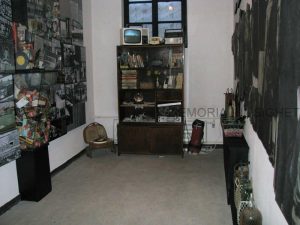 Everyday life under communism followed a winding path, depending on economic and political conditions.
Everyday life under communism followed a winding path, depending on economic and political conditions.
The nationalisation of industry, the collectivisation of agriculture, and Soviet-type five-year plans led to a decrease in economic productivity and to equalisation of the population in poverty. In the first period of communism, suffocating Stalinist propaganda masked everyday poverty.
After the relative economic recovery and political liberalisation in the years following 1964 (the year in which independence from Moscow was declared), the communist regime sank back into economic and cultural deterioration, caused by hyper-industrialisation, the centralised investments system, Romania’s regress into marked cultural isolation, and a Chinese/North-Korean-style cult of personality.
The two periods are illustrated in this room by the typical objects, images and sounds, commonplaces, customs, uniforms, models, slogans, popular songs, taboos, and mentalities that were part of everyday life for the majority of Romania’s population, those who did not live behind bars, but were allowed the “freedom” of a life under surveillance outside the prison walls..









